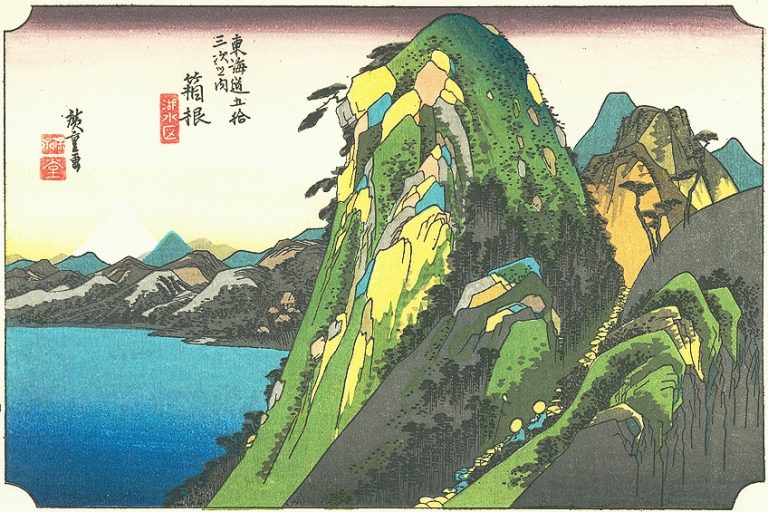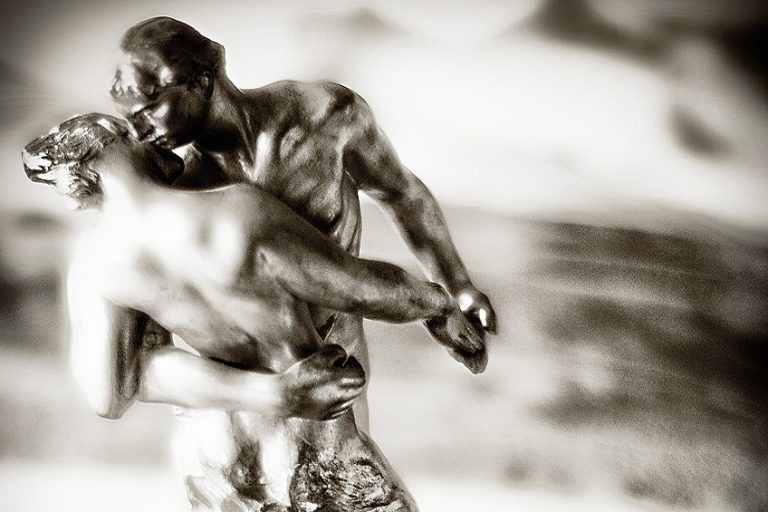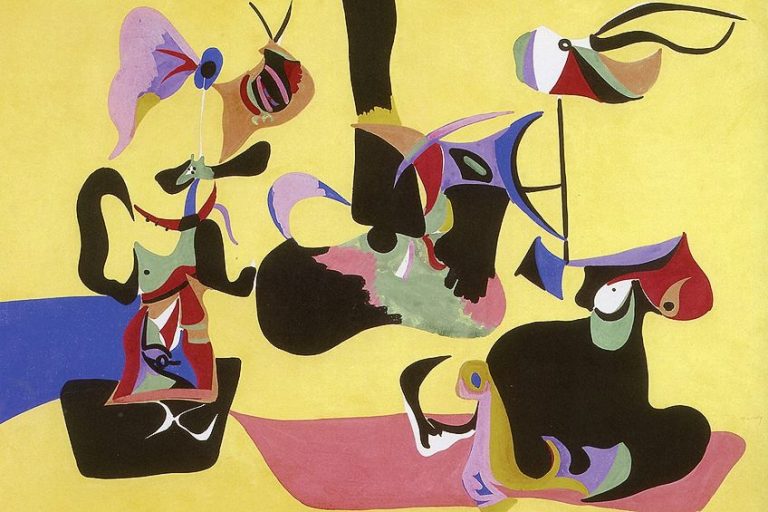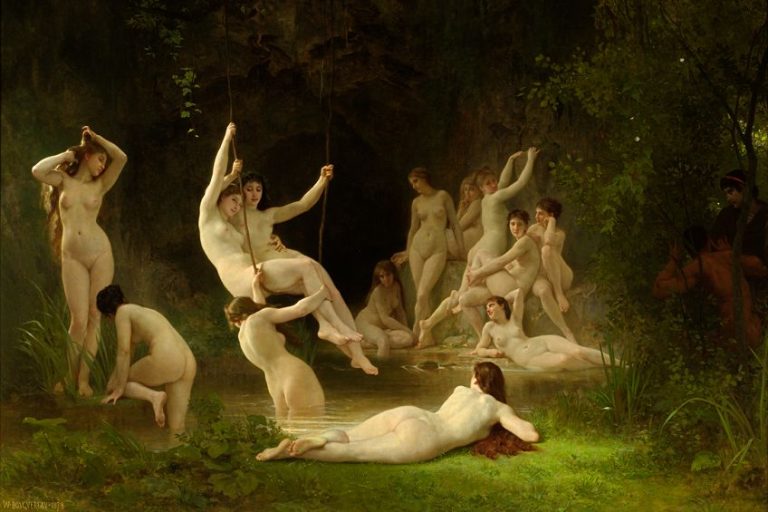William Turner – The Life and Romantic Works of J. M. W. Turner
Romantic painter Joseph Mallord William Turner, also known as J. M. W. Turner or William Turner, was a famous British watercolor artist. He meditated on the rising significance of personal experiences in the Enlightenment age when human perception led to elevated personal experiences and exquisite relationships with nature, and in doing so, Turner’s landscapes were imbued with new vitality. William Turner’s paintings helped establish the cross-disciplinary creative style of Romanticism, laying the groundwork for later breakthroughs in portraying subjective sensations that would culminate in Impressionism.
A William Turner Biography
J. M. W. Turner neglected and even shattered the accurate portrayal of details and motionless situations that preceding generations’ masters and contemporaries still attempted in pursuit of larger subjective effects. Rather, he experimented with artistic approaches to depict sensations from a carefully observed environment, culminating in whirling masses of varying light and strong palettes of color splattered in oil.
Several of these painting approaches for producing “exquisite” feelings would become the substance and theme of the Abstract Expressionist era.
Many of William Turner’s paintings highlighted the force of nature in ways that had not hitherto been shown, making the human figure and everything that society had constructed appear microscopic and frail in contrast.
| Nationality | British |
| Date of Birth | 23 April 1775 |
| Date of Death | 19 December 1851 |
| Place of Birth | Covent Garden, London |
Childhood and Education
Joseph Mallord William Turner was sent to reside with an uncle in a tiny rural town of Brentford when he was ten years old, owing to his mother’s indications of psychological instability. Turner started his creative endeavors there in Brentford by coloring a series of etched plates. He was transferred to Margate in 1786, where he attended school and began painting the village and its environment.
Throughout his career, he would depict the village and its surroundings and then use those sketches to produce finished works.
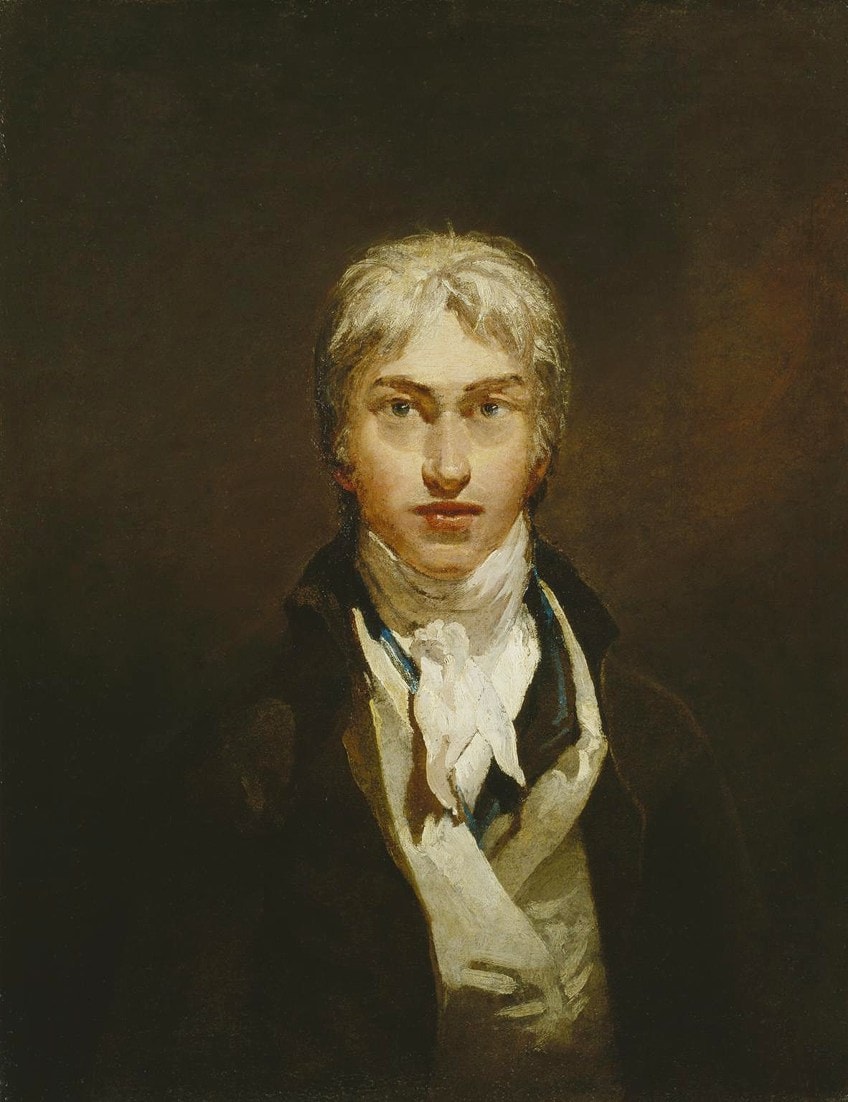
Despite living in several parts of London and then traveling extensively, he stayed a Londoner all through his lifetime. J. M. W. Turner, unlike many of his colleagues, did not acquire an elitist demeanor as he ascended the career hierarchy. In comparison, John Constable notoriously jousted for rank in terms of social standing, practically displacing a Turner work in a Royal Academy exhibit for a piece of his own work.
Despite spending time in the company of noble clients, Turner chose to visit his humbler mansions in Chelsea and the fishing resort of Margate, even later in life, while also residing constantly in the country and beach in search of striking themes out in nature.
Early Period
Turner began his career by creating architectural studies for numerous architects and eventually collaborated with a topographical draftsman. As a result, architectural elements may be found in many of his early paintings and sketches. He attended the elite Royal Academy of Art aged 14 and was approved as a fellow a year later. The Academy, founded in 1768 by an order of King George III, was an important style mediator as well as a significant center in the network of potential purchases and orders – mainly from the Royal Family and nobility – for its artistic participants.
Despite his passion for architecture, Thomas Hardwick recommended that he pursue painting. In the winters, he painted, and in the summertime, he traveled around England and Wales. In 1796, William Turner’s very first art piece, Fishermen at Sea, was displayed at the Royal Academy.
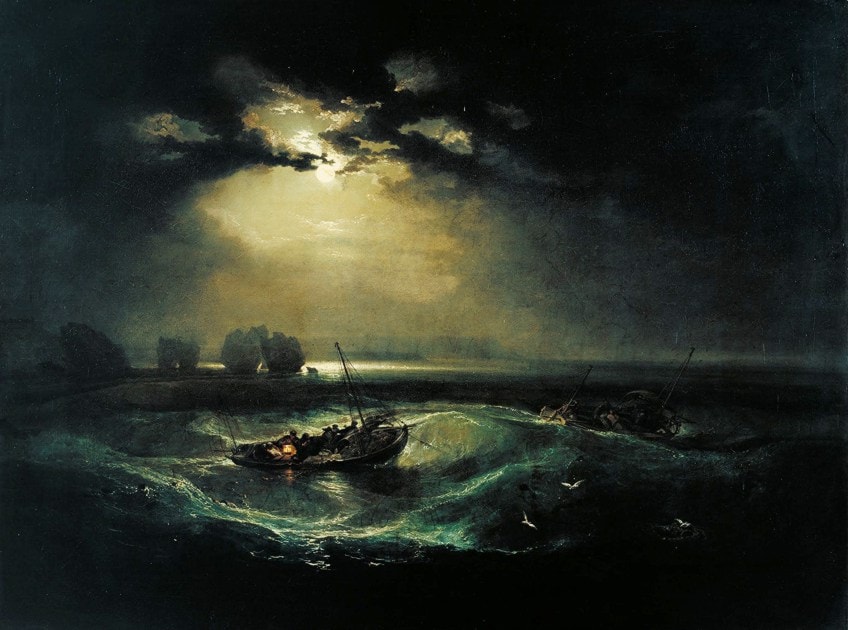
It was a moonlit night time moonlight scene, which was a prominent type of painting at the time. He was recognized for this work, which defined him as an oil painter as well as a depicter of nautical landscapes. He painted a favorable self-portrait at this period, expressing his opinion that he had “arrived.” In 1802 he was elevated to the rank of full academician.
He rose to prominence in 1807, at the age of 32, when he was appointed professor of perspective.
By 1800, he had become financially secure and had relocated to a superior address in London. In order to exhibit his works, he established a gallery in 1804. In 1802, he expanded his travels to Europe, visiting France and Switzerland. A group of aristocrats funded this excursion, and he was provided with a French-speaking interpreter and a modest bus. He chronicled the expedition in his artwork, Calais Pier (1801), and did over 400 sketches throughout the trip.

Mature Period
Turner tried to perfect other genres he lauded in his early works of art, such as the lifelike, organized pictorial methods of Claude Lorrain and Willem van der Velde, but by 1805, his oil drawings and works of art such as The Shipwreck illustrated his own unique methodology to landscapes and coastlines. By his late 30s, his art had become more ethereal and brilliant.

In works like Snowstorm: Hannibal and his Army Crossing the Alps (1812), he began to concentrate his energies on depicting the forces of nature and man’s frailty in the presence of it, while also providing a historical portrayal.
Turner was fascinated in poetry, particularly that of Lord Byron, Thomas Moore, Walter Scott, and John Milton, and he composed his own poetry, notably an incomplete and unreleased piece, “Fallacies of Hope”, in 1812.
Turner was given permission to travel abroad again after the Napoleonic Wars finished in 1815. He took his first voyage to Italy in the summer of 1819, seeing Naples, Rome, Florence, and Venice. During this period, he created over 1,500 sketches from which he created many paintings.
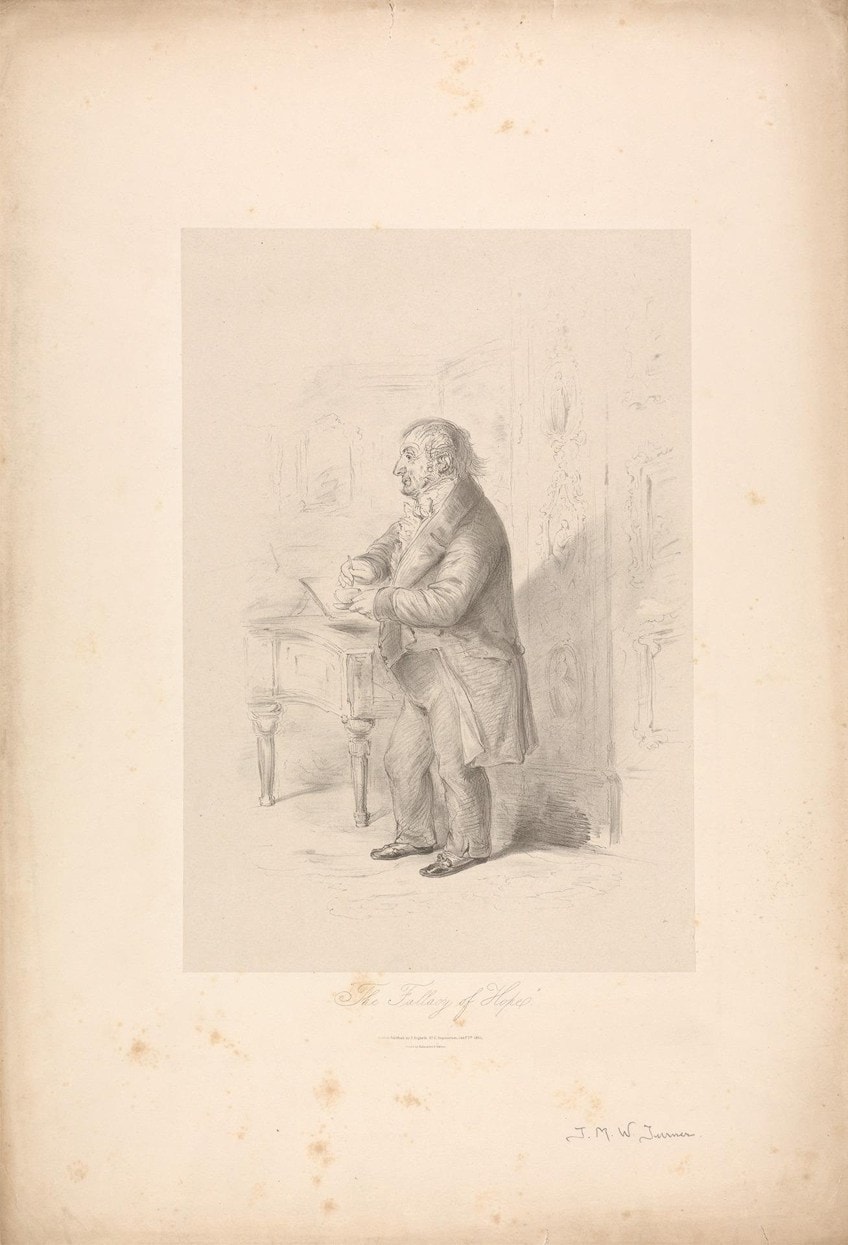
These paintings, such as The Grand Canal, Venice (1835), show a change in his color usage, with several transparent layers, warm colors and cool colors forming structure, and a wider range in general. Turner was extremely secretive about his personal affairs, and as he got older, he grew quirkier. He had few close acquaintances, but his father, who resided with him for 30 years and served as his workshop helper, chef, and gardener, was his closest companion.

His mother died in 1804, most likely at a mental institution in Bethlehem. Turner suffered from despair when his father died in 1829. Although he never wedded, he did have a couple of offspring with Sarah Danby. In one of his art books, Turner wrote, “Woman is questionable love,” and there is the possibility that the real mother of his children was Sarah Danby’s niece, who worked as his domestic for a spell.
Late Period
In his final years, Turner traveled continuously, visiting Switzerland, Italy, Germany, France, Denmark, and Czechoslovakia. He drew often during his travels, and his gift included roughly 19,000 sketches from his trips. William Turner’s paintings began to become more flowing and ethereal, with fewer features. Train, Steam, and Speed – the Great Western Railway is a prominent illustration from this time period (1844).
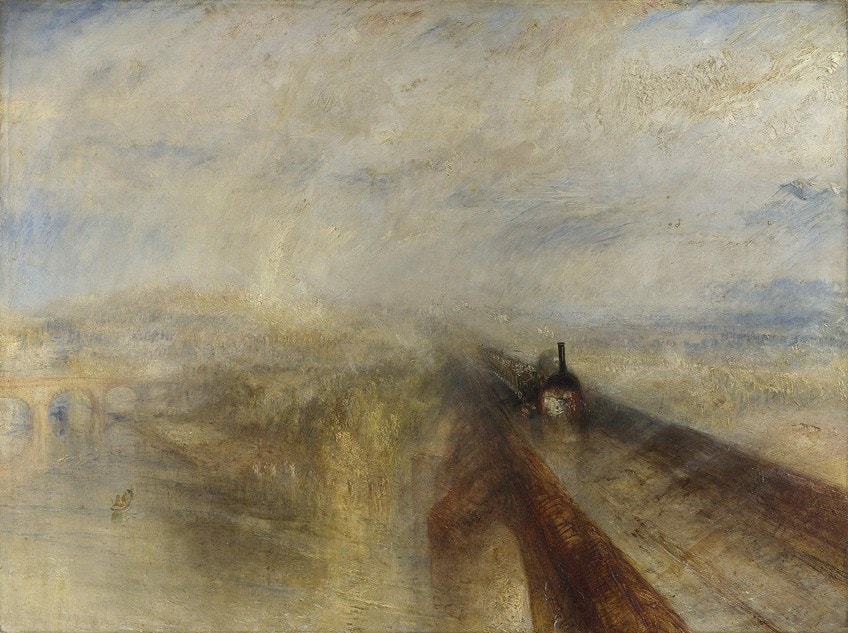
These artworks depict Turner’s response to the transformations set about by the Industrial Revolution. Turner’s inventive approach in his later paintings was widely challenged, an English art critic and long-time fan of the Romantic painter, John Ruskin, defended him in his book Modern Painters (1843-1860).
Legacy
Joseph Mallord William Turner passed away on the 19th of December, 1851. He committed the most of his income to a foundation for “decayed painters,” and he gifted his completed works to the National Gallery. The family acquired a large portion of the money as a result of the case, and both the finalized and incomplete works became public property.
The bulk of William Turner’s paintings are now housed in the Tate Britain, with the National Gallery owning a few of noteworthy works.
J. M. W. Turner’s effect on artists has been felt for more than two hundred years: his representation of the divided humanity met when presented with the consequences of their own mechanical inventions in the modern age was an initial effort to cope with the Industrial Revolution. Even more powerful was his manner of representation: impressionistic depictions of natural events that reflected interior psychological sentiments to the point of extreme, exceptionally early abstraction – to a level that artists would only deal with as completely more than a hundred years later.
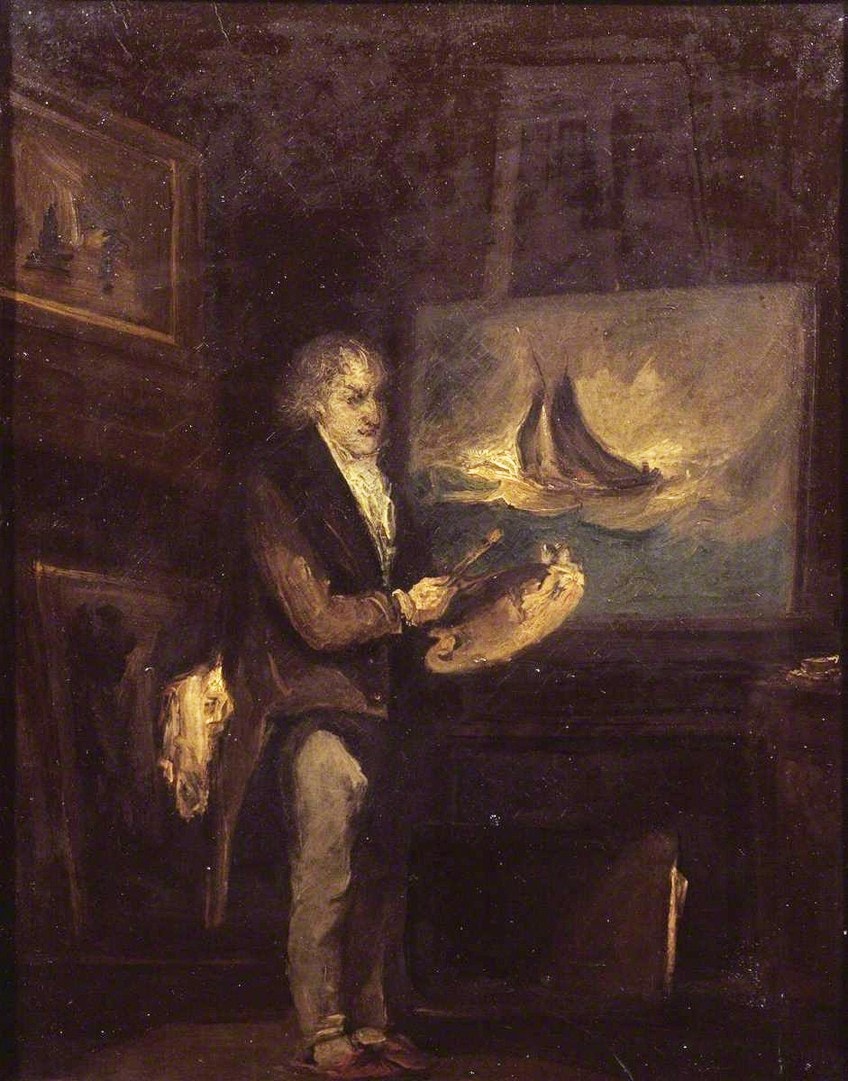
Turner’s landscapes, particularly his later work, were highly regarded by abstract painter Mark Rothko. Rothko’s enormous paintings with delicately shifting layers of color show the impact. Rothko was quoted as remarking, “This man Turner, he learned a lot from me.”
This remarkable reception of a pre-modern master’s work by a museum devoted to modern art demonstrated the radical character of Turner’s involvement with topics that were not just ahead of their time but are still pertinent today. Turner’s previous experiments with light and color also motivated the emerging artist Olafur Eliasson to develop a sequence of color experimental tests, each influenced by a distinct Turner artwork.
“I painstakingly analysed the quantity of color tones, darkness, and brilliance in a set of Turner works, and then constructed a type of ‘color chart portraiture’ of each one, using the precise same colors and quantity of light and darkness,” Eliasson says.
William Turner Paintings
Turner’s painting technique evolved noticeably during his lengthy career as an artist. While his early work focused on the landscape style, as his career evolved, he started to devote less attention to the intricacies of items and landscape and more emphasis to the impact of light and color. He got more and more captivated by natural and atmospheric components.
Turner, on the other hand, was a careful observer and recorder of his surroundings as a young artist.
Many of his paintings emphasized nature’s strength in novel ways, making the human form and all humanity had made look small and fragile in comparison. Turner also integrated unique themes from the industrial era into his works of art, with railway trains and steamships prominently featured, foreshadowing a recurring fascination with these components of modern life that would figure in subsequent generations of creatives.
Dutch Boats on a Gale (1801)
| Date Completed | 1801 |
| Medium | Oil on Canvas |
| Dimensions | 162 cm x 221 cm |
| Current Location | The National Gallery, London |
This artwork was requested by the third Duke of Bridgewater as a counterpart piece to Willem van de Velde the Younger’s 17th-century seascape, Ships on a Stormy Sea. Turner depicts dark skies and a turbulent sea with boats straining on the choppy water in this artwork. Turner’s vessels, in contrast to the companion piece, seem like they are about to collide, evoking a sense of impending danger. This 1801 picture exhibits the impact of Dutch painters on Turner’s early efforts, but it also has the instability that became one of Turner’s signature characteristics.

Snow Storm: Hannibal and his Army Crossing the Alps (1812)
| Date Completed | 1812 |
| Medium | Oil on Canvas |
| Dimensions | 237 cm x 146 cm |
| Current Location | Tate, United Kingdom |
Turner shows Hannibal’s forces attempting to traverse the Alps in 218BC in this picture. A curving arch of dark clouds hovers above the warriors, with a brilliant sun shining through the gloom. Soldiers battle indigenous tribes in the foreground in the gloomy darkness, while the Italian fields beyond are drenched in sunshine. An avalanche of snow is sliding the mountain to the right. Hannibal’s exact location is unknown; however, he may be charging on the elephant in the distance.
During the war between France and Britain, Turner made this picture.
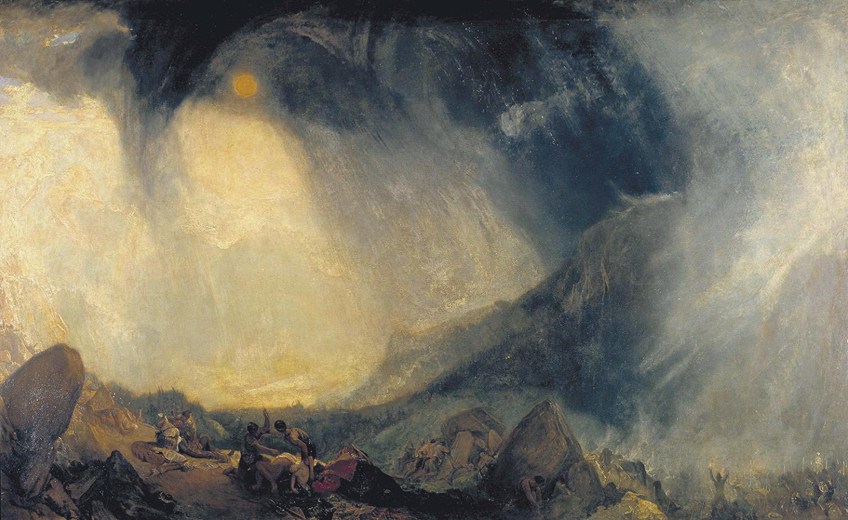
He recognized connections between Napoleon and Hannibal and created this picture in reaction to Jacques-Louis David’s portrayal of Napoleon Crossing the Alps (1805). This is the first picture in which Turner used a whirling vortex of winds, rainfall, snow, and clouds, a technique he used frequently in later works. His continual studies of lighting and atmosphere had a significant impact on subsequent Impressionists and Post-Impressionists such as Pissarro and Monet.
The Burning of the Houses of Parliament (1834)
| Date Completed | 1834 |
| Medium | Watercolor |
| Dimensions | 92 cm x 123 cm |
| Current Location | Tate, United Kingdom |
In 1834, a fire consumed the Houses of Parliament and burnt for hours while Londoners looked on in horror. Turner captured the panorama from the Thames River in a sequence of drawings, watercolors, and oil paintings.
This watercolor and gouache on paper painting depicts a closer look at the fire and individuals gathering to observe it.
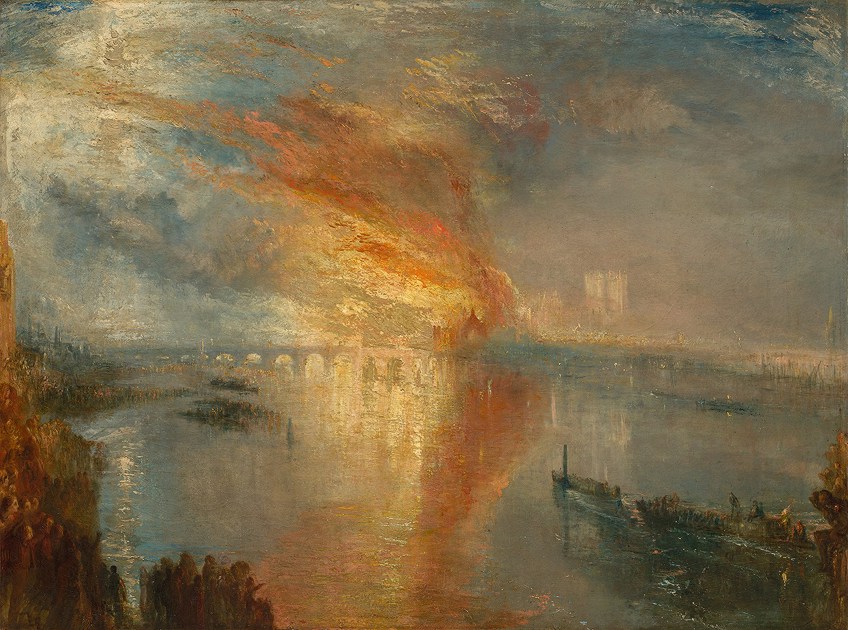
Turner employs color to portray the amazing light and heat that is as much the focus of the picture as the burning structure itself. Turner’s choice for the conflagration’s elemental aspects, as well as the fire itself, reflects another of his favorite topics: the relative unimportance and insignificance of man’s achievements in the face of nature.
The Fighting Temeraire Tugged to Her Last Berth to Be Broken Up (1839)
| Date Completed | 1839 |
| Medium | Oil on Canvas |
| Dimensions | 90 cm x 121 cm |
| Current Location | The National Gallery |
Turner shows a once-mighty and majestic cruiser being pulled to its demise, where it will be cut up for scrap. The ship appears in the artwork as a ghost in the backdrop, being towed by a little, black, steam-powered tugboat. The surviving vessels’ sails form a triangle within a larger triangle of blue sky in the background. The sun is setting behind the Temeraire, and the moon is illuminating the river.
This picture represents the end of an age, the decline of heroic power, and the arrival of the Industrial Revolution.
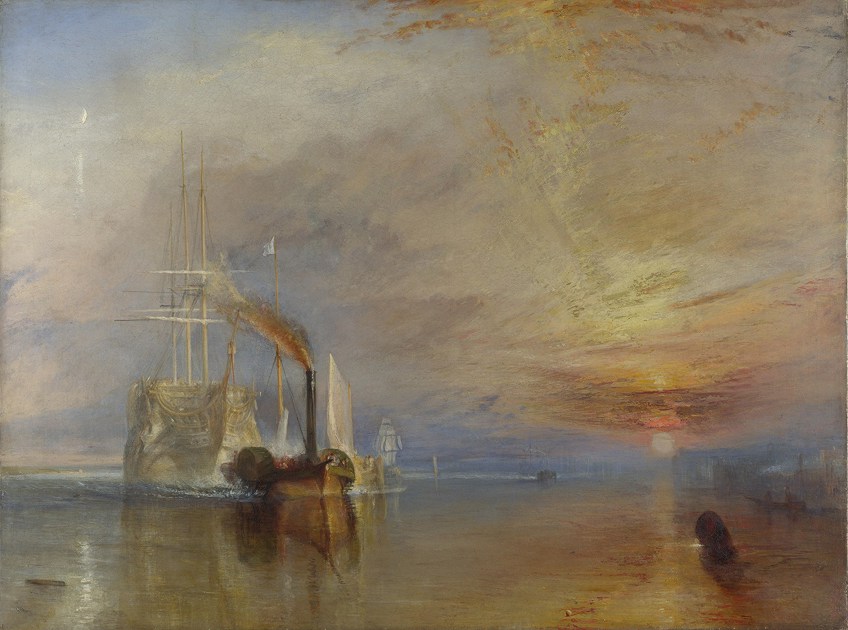
Steam-powered boats were gradually replacing huge sailing vessels. It has been believed that the ship represents Turner himself as he reflected on his past successes, his mortality, and watched younger artists getting noticed. Turner took various liberties in depicting this incident; for example, the Temeraire’s masts were not unbroken when it was towed. He wanted to depict her in her former majesty, therefore he incorporated them in the picture.
His modification of details revealed a release from “simply facts,” which inspired subsequent contemporary artists to feel freer in their interpretations of presented settings.
Slave Ship (1840)
| Date Completed | 1840 |
| Medium | Oil on Canvas |
| Dimensions | 91 cm x 123 cm |
| Current Location | Museum of Fine Arts |
Turner depicts a ship in the backdrop sailing over a stormy sea, and in the foreground, in the wake of the vessel, individuals with shackles on their legs, while fish and ocean animals hover around, seeming dangerously ready to consume them. Turner based this picture on a poem about the Zong, a slave ship stranded in a storm.
The real tragedy of that ship took place in 1781, when its commander ordered 133 sick and suffering slaves tossed overboard in order to claim the insurance payout.
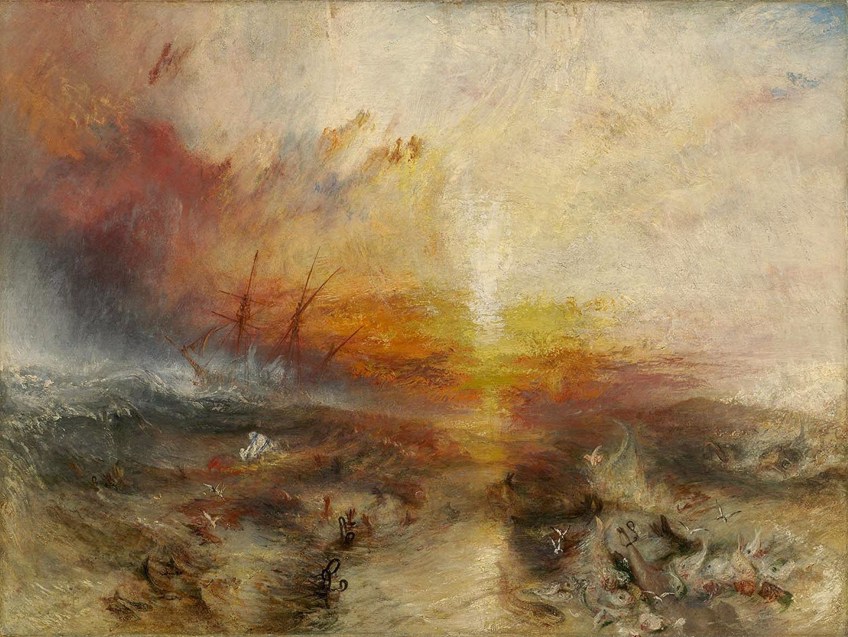
Turner arranged the display of this artwork to correspond with the British Anti-Slavery Society’s conference. Even though the British Empire had abolished slavery in 1833, Turner felt it should be abolished worldwide, and he hoped that when Prince Albert saw the artwork, he would be spurred to intensify anti-slavery activities.
Light and Color (Goethe’s Theory) (1843)
| Date Completed | 1843 |
| Medium | Oil on Canvas |
| Dimensions | 78 cm x 78 cm |
| Current Location | Tate, United Kingdom |
The odd shape of this latter work, with even proportions on all sides, implies neither the traditional orientation for the genres of landscape nor portrait, directing the conscious experience further by concentrating the audience’s sight into the core of a type of elemental maelstrom. The main characters – Moses and a snake – are shown hazily among the type of apparently shapeless fields of light and color that Turner’s peers frequently criticized in his later works.
Meanwhile, the comparative brilliance of Turner’s colors in this melancholy piece alludes to darker parts of the Biblical theme of salvation following the flood.
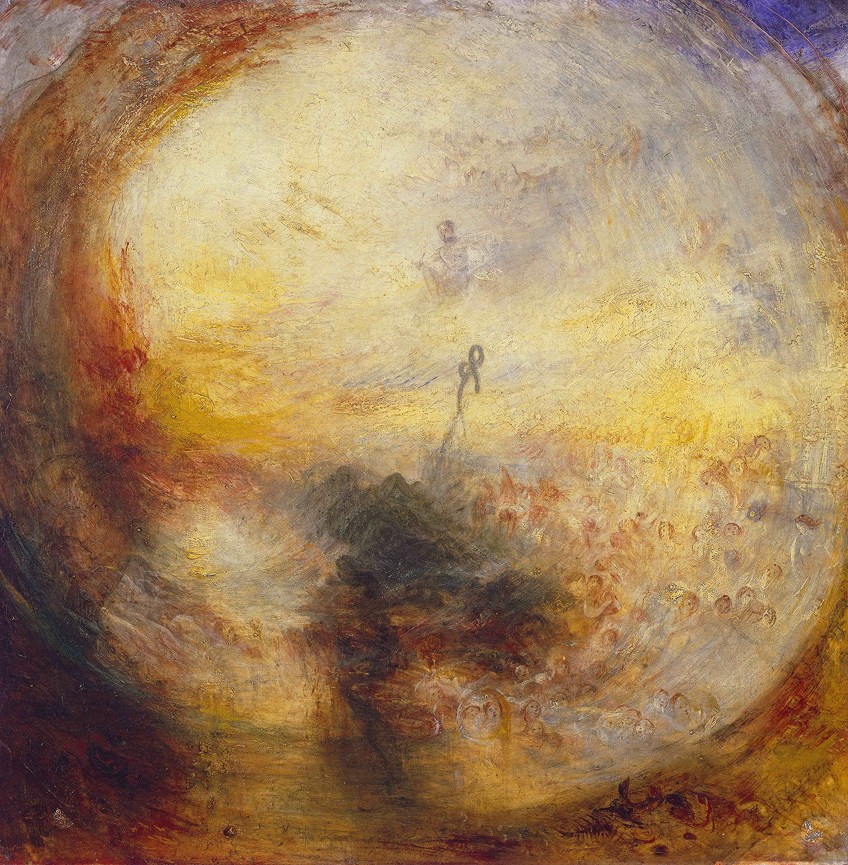
This is related to the piece’s subtitle, in which the possible sense of triumph or relief for people who escape such disasters is mingled with the knowledge that the very same sinister forces may generate a new crisis at any point in the future. Turner is a rendition of the Biblical story as seen via a perceptual filter connected to Goethe’s mental and theoretical interpretation of how people truly see color as a phenomenon.
Turner advances a Romantic updating of both the traditional Biblical account and the works of Goethe – another instance of later-day Classicism and archetypal initiator of Romantic conceptions – in the age preceding Turner’s own.
Rain, Steam and Speed – The Great Western Railway (1844)
| Date Completed | 1844 |
| Medium | Oil on Canvas |
| Dimensions | 91 cm x 122 cm |
| Current Location | National Gallery, London |
Turner’s artwork depicts a train approaching in the countryside during a summer thunderstorm. The train in the middle is gloomy and rain-shrouded, flanked on both sides by a brilliant natural environment. The bridge and train, the painting’s concrete features, are, however, scarcely hinted at, vanishing into the misty and surreal environment.
The mist coming from the lake, the rain obscuring the sky, and the steam from the train are all blurred and combined together, uniting the colors in the picture.
On the lower-left corner of the picture, a small person in a boat can be seen, suggesting that the overpass is erected on top of a river. In the lower right corner of the painting, a rabbit rushes down the rail. White plumes of steam rise in the air by the engine, indicating that the train is moving. The first puff, which is nearest to the motor, is the most obvious, while the other two recede into the background. As the puffs are gradually left behind, this detail gives the impression of speed.
Turner painted a multitude of waving persons in the train’s cabin, serving as a message that the railway was a cheerful and popular amusement. Turner typically used an ambient tone in his creative works by applying paint to the canvas in short, sweeping brushstrokes from a dirty palette and gradually sculpting shapes out of his color foundation.
Turner utilized a heavy impasto with a palette knife in the painting’s center and upper right. To represent rain, he slapped a muddy putty on the panel with a trowel, while the sun glinted from large, smeary pieces of chrome yellow. Turner also used cool crimson lake tones to convey the shadow, and while the flame in the steam locomotive seems red, it was most likely made with green and cobalt.
The picture is structurally sound, with a well-balanced arrangement of shapes and a sturdy mathematical foundation.
Recommended Reading
Romantic painter Joseph Mallord William Turner was known for his landscape and seascape artworks. Our William Turner Biography serves as a great introduction to Turner’s landscapes and life. But perhaps you would like to learn even more about this famous watercolor artist. Check out these books on J. M. W. Turner if you are interested.
J. M. W. Turner (2007) by Ian Warrell
J. M. W. Turner, which is accompanied by the largest exhibition of his work ever presented in the United States, demonstrates how Turner’s groundbreaking portrayals of illumination, hue, and ambiance in the scenery, blended with his knowledge of the transcendent in nature, elevated him to the ranks of the most renowned and acutely studied European painters in the world. Landscape paintings were seen as the art form most directly associated with the newly independent state’s identity, and Turner’s magnificent works functioned as a template for a new school of American artists.
- Accompanying the largest exhibition of Turner's work ever presented
- How the artist is among the most acclaimed artists in the New World
- Discusses how Turner provided a foundational model for US artists
Turner Watercolors (2020) by David Blayney Brown
Few can deny that J. M. W. Turner was the most prominent exponent of British watercolor throughout its golden period. He was a frequent traveler in pursuit of the perfect scenery, and he never left the house without a loose-bound notebook, pencils, and a little carrying bag of paints in his pocket. He used the medium’s brilliance and transparency like no one before him, creating illumination on Venetian lagoons and English meadows, as well as billowy clouds over lakes and mountains. He was exceptional in his own time, and he has continued to amaze his legions of fans ever since.
- About the greatest exponent of British watercolor in its golden age
- Written by one of the world's leading experts on Turner
- Reveals the role watercolors played in Turner's life and works
J. M. W. Turner, widely recognized as one of the finest personalities in art history, had a significant impact on the formation of Impressionism. What is less well recognized is that his impact extended well beyond Europe and served as a model for American painters. Turner is regarded as the first modern artist because his untidy, expressive technique and vibrant colors influenced many contemporary painters.
Take a look at our J.M.W. Turner paintings webstory here!
Frequently Asked Questions
Who Was William Turner?
Watercolor artist William Turner reflected on the growing importance of personal experiences during the Enlightenment period, when human awareness led to higher personal experiences and exquisite interactions with nature, and his landscapes were filled with fresh energy as a result. William Turner’s paintings contributed to the development of Romanticism’s cross-disciplinary creative approach, setting the framework for later achievements in depicting subjective feelings that culminated in Impressionism.
What Was William Turner Famous For?
Turner’s painting style improved dramatically throughout the course of his long career as an artist. Although his early work focused on environmental aesthetics, as his career advanced, he began to focus less on the intricacies of products and landscape and more on the effect of light and color. Natural and ambient factors captivated him more and more. As a young artist, Turner, on the other hand, was a keen observer and recorder of his environment.
Isabella studied at the University of Cape Town in South Africa and graduated with a Bachelor of Arts majoring in English Literature & Language and Psychology. Throughout her undergraduate years, she took Art History as an additional subject and absolutely loved it. Building on from her art history knowledge that began in high school, art has always been a particular area of fascination for her. From learning about artworks previously unknown to her, or sharpening her existing understanding of specific works, the ability to continue learning within this interesting sphere excites her greatly.
Her focal points of interest in art history encompass profiling specific artists and art movements, as it is these areas where she is able to really dig deep into the rich narrative of the art world. Additionally, she particularly enjoys exploring the different artistic styles of the 20th century, as well as the important impact that female artists have had on the development of art history.
Learn more about Isabella Meyer and the Art in Context Team.
Cite this Article
Isabella, Meyer, “William Turner – The Life and Romantic Works of J. M. W. Turner.” Art in Context. April 13, 2022. URL: https://artincontext.org/william-turner/
Meyer, I. (2022, 13 April). William Turner – The Life and Romantic Works of J. M. W. Turner. Art in Context. https://artincontext.org/william-turner/
Meyer, Isabella. “William Turner – The Life and Romantic Works of J. M. W. Turner.” Art in Context, April 13, 2022. https://artincontext.org/william-turner/.






